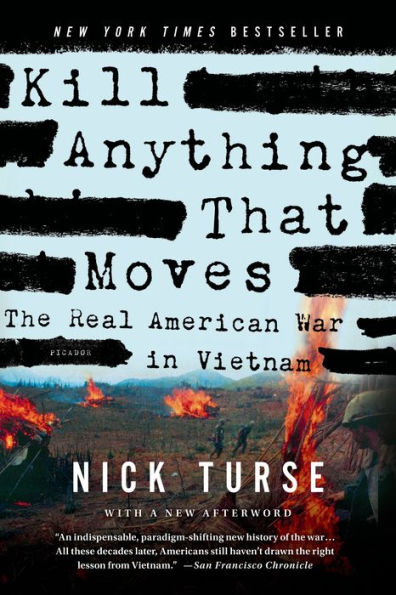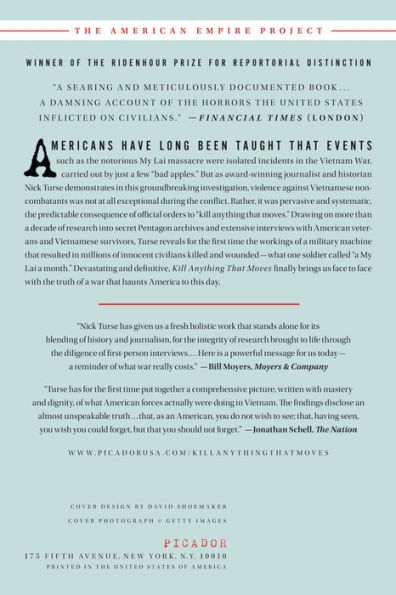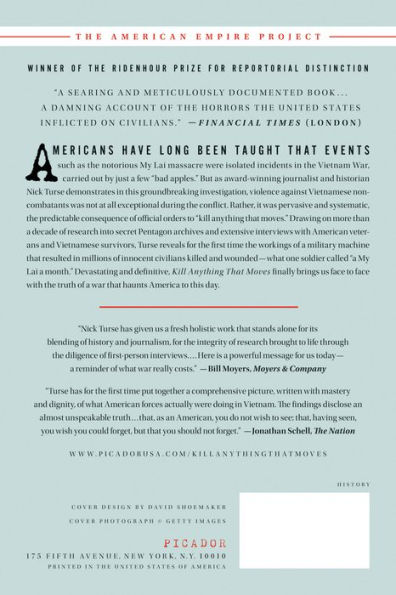Read an Excerpt
Kill Anything That Moves
The Real American War In Vietnam
By Nick Turse Picador
Copyright © 2013 Nick Turse
All rights reserved.
ISBN: 978-1-250-04506-5
CHAPTER 1
THE MASSACRE AT TRIEU AI
In 2008, visiting Trieu Ai village in Quang Tri, the northernmost province in South Vietnam, meant driving down a long, winding, rutted road of crushed rock and burnt-orange mud. It was slow going, as the car rocked and pitched past shattered concrete buildings, through forests, across fields. The last mile or two had to be traversed on foot, though the worst to worry about, while slogging through the mire, was losing a shoe. Forty years before, the Americans trudging through this area had far more to fear.
On the night of October 21, 1967, members of Company B, 1st Battalion, 1st Marine Regiment, in the midst of a long, grueling patrol, found themselves on the outskirts of Trieu Ai. On a hill overlooking the village, one of the Americans tripped a booby trap. A well-liked marine from the company's 1st Platoon was killed, three others were injured, and the embittered, frustrated troops hunkered down, awaiting a medical evacuation—"medevac"—helicopter.
It was a commonplace story. Vietnamese revolutionary forces, decisively outgunned by their adversaries, relied heavily on mines and other booby traps, as well as sniper fire and ambushes. Their way of war was generally to strike swiftly and immediately withdraw. Unable to deal with an enemy that overwhelmingly dictated the time, place, and duration of combat, U.S. forces took to destroying whatever they could manage. Often, civilians paid the price.
Soon after the booby trap struck his men, Lieutenant Robert Maynard held a briefing with Lieutenant John Bailey and Sergeant Don Allen of the 1st Platoon. Maynard assured them, Allen later reported, that they would get "first crack at the ville." He remembered the orders vividly: "We would take our platoons and move through the ville. When we reached the other side 'there was nothing to be left alive or unburned, as far as the children goes, let our conscience be our guide.'"
When Lieutenant Bailey, who had been slightly wounded by the booby trap, returned from the briefing, he too told his platoon that they were about to be sent into the village. Lance Corporal Olaf Skibsrud recalled the orders passed on to him: "They said that we were going to kill everyone in the ville and burn it down." Lance Corporal Eddie Kelly remembered Bailey's orders as "search-and-destroy everything in the village." And rifleman Edward Johnson recalled a command similar to so many others handed down by Americans all over South Vietnam, year after year: "We was going to kill anything that we see and anything that moved."
* * *
The marines who would need to call on their consciences concerning the children of Trieu Ai were not that far from childhood themselves. Indeed, most U.S. troops who served in Vietnam were in their teens or barely out of them. Whether they had been drafted or had volunteered (often to avoid the uncertainty of the draft), they had gone off to basic training as little more than boys.
The boot camp experience was consciously organized to reduce recruits to a psychological state akin to early childhood. Their previous eighteen or so years of learning were to be stripped away through shock, separation, and physical and psychological stress, creating a tabula rasa on which a military imprint could be stamped. For eight weeks of up to seventeen-hour days, every detail of their lives was prescribed, every action relearned in a military manner, all stringently enforced by the omnipresent authority of the drill instructor. As historian Joanna Bourke puts it, a deft combination of "depersonalization, uniforms, lack of privacy, forced social relationships, tight schedules, lack of sleep, disorientation followed by rites of reorganization according to military codes, arbitrary rules and strict punishment" was brought to bear to accomplish the task.
Frequent punishments, meted out for infractions as simple as not beginning and ending every sentence with "sir," were crucial to the process. They consisted of both psychological debasement and physical suffering—everything from being forced to eat garbage to being exercised to the point of collapse. At the same time, everyday training itself could be an agonizing experience. Even the best athletes were often overtaxed by the grueling workouts. "Simple exhaustion," as the historian Christian Appy points out, was a "key factor in explaining the willingness of recruits to follow orders" since they soon "learned that disobedience of any kind only brought more pain."
Recruits were also indoctrinated into a culture of violence and brutality, which emphasized above all a readiness to kill without compunction. Like many soldiers, the Vietnam-era draftee Peter Milord told Appy that at first he only mouthed the violent chants during his army training—"Kill! Kill! Kill! To kill without mercy is the spirit of the bayonet!"—but later found himself being overtaken by the ethos. "I didn't become a robot," Milord said, "but you can get so close to being one it's frightening." Another veteran put it this way: "For eleven months I was trained to kill. For eight weeks, during basic training, I screamed 'kill,' 'kill.' So when I got to Vietnam I was ready to kill." Still another told me that after having chanted "kill, kill, kill" through basic training, advanced infantry training, and long-range reconnaissance patrol instruction, he felt absolutely "brainwashed."
Remorseless killing was additionally legitimized by the explicit racism that suffused the training. As army veteran Wayne Smith remembered, "The drill instructors never ever called the Vietnamese, 'Vietnamese.' They called them dinks, gooks, slopes, slants, rice-eaters, everything that would take away humanity ... That they were less than human was clearly the message." Similarly, veteran Haywood Kirkland described his experience this way.
As soon as [you] hit boot camp ... they tried to change your total personality ... Right away they told us not to call them Vietnamese. Call everybody gooks, dinks. They told us when you go over in Vietnam, you gonna be face to face with Charlie, the Viet Cong. They were like animals, or something other than human ... They wouldn't allow you to talk about them as if they were people. They told us they're not to be treated with any type of mercy ... That's what they engraved into you. That killer instinct.
This attitude was reinforced once soldiers arrived "in-country." Many recall immediately being told that, whatever the official policy, in reality all Vietnamese were to be distrusted, that even women and small children were possible foes or outright enemies—a particularly sinister attitude in the context of a war that was supposedly being fought to protect Vietnamese civilians from communist aggression. A child, GIs believed, might throw a grenade or be strapped with explosives. An elderly woman could help to construct booby traps. Though official military publications aimed at troops headed for Vietnam stressed discrimination between civilians and guerrillas, some of them still suggested that everyone in a conical hat or the loose-fitting Vietnamese clothes that Americans called "black pajamas" was a potential adversary.
One veteran told me that his training made it clear that the "enemy is anything with slant eyes who lives in the village. It doesn't make any difference if it's a woman or child." An officer summarized the prevailing mind-set: "So a few women and children get killed ... Teach 'em a damned good lesson. They're all VC or at least helping them ... You can't convert them, only kill them."
Among the many reasons for this suspicion was that, in village after village, U.S. patrols regularly encountered women and children plus a few old men, but almost no military-age males. "All through the whole entire time that I spent out in the field, I could literally count the amount of men or boys that we saw," one veteran who spent a year in combat told me. "You go into a village, and there was never a man in a village. Never," said another. To Americans, the reason was obvious: the "missing" men, all the village's sons and husbands, were Viet Cong guerrillas. This was, of course, one definite possibility. But it was also quite possible that the men were serving in the U.S.-allied South Vietnamese forces; or were draft dodgers, hiding from armies of both sides; or were off working in a distant rice paddy, market, or town, trying to earn a living. In any case, most older boys and young men knew to flee whenever U.S. or South Vietnamese troops arrived, since they were prime targets for conscription, arrest, or execution. Women with children and elders couldn't move as fast and stood a somewhat better chance of being spared, so they were often left behind.
Many U.S. soldiers were also suspicious because South Vietnamese villagers always seemed to know where to walk to avoid VC booby traps. This wasn't really true; civilians were also, in fact, killed or wounded by such weapons. But to the soldiers, the fact that the peasants didn't warn them about these dangers was more clear evidence that the locals were supporting the VC, if not members themselves.
The soldiers also had trouble sorting out who was who. Troops often got only fleeting glimpses of figures dressed in the loose-fitting "black pajamas"—which, in the countryside, were actually worn by men and women, young and old, civilians and guerrillas alike. From a distance, a black-clad female farmer with a hoe could be indistinguishable from a male fighter with a rifle. Unable to readily tell friend from foe, and often unwilling to take the risk of trying to do so, many troops simply decided to fire on anyone they saw. And they often did so with the tacit support of or on explicit orders from superiors.
It was illegal to order the killing of unarmed villagers, no matter whom they supported in the war. But illegal orders were not uncommon, and how soldiers should react to them was, at best, unclear. During boot camp or in-country instruction, many soldiers were given a short lesson—generally about an hour long—on the laws of war, but it paled in comparison to the weeks of training that suggested a very different standard operating procedure. As the psychiatrist and war crimes expert Robert Lifton notes, there was "a striking contrast between the formal instruction (given rotely if at all) to kill only military adversaries, and the informal message (loud and clear) to kill just about everyone."
What's more, basic training emphasized that obedience to commanders was paramount. Using an instructional outline in the army's field manual, a chaplain would often put forward an Orwellian-sounding concept: "The freest soldier is the soldier who willingly submits to authority." Invoking both honor and self-interest, the chaplain would tell recruits, "When you obey a lawful command you need not fear, nor worry." However, no clear definition of an unlawful order was offered, and young recruits were pressed to exhibit simpleminded obedience. Nor did they receive any specialized training regarding the added responsibilities and moral complexities of fighting a guerrilla war in villages filled with civilians.
Meanwhile, the young officers to whom these recruits were to show blind obedience, men like Lieutenants Maynard and Bailey at Trieu Ai, had often themselves received exceptionally lackluster instruction in the laws of war. In 1965, the reporter and historian Bernard Fall surveyed American small-unit commanders in Vietnam and found that few had anything but "the vaguest idea" about the 1949 Geneva Conventions. Some even argued that, contrary to the laws of war, "VC were all 'traitors' and thus could be shot out of hand" after being taken prisoner.
In 1967, Fall's findings were validated in a study of junior officers at the U.S. Army Intelligence School at Fort Holabird, Maryland, which found that even at this specialized training center there were students who showed "a lack of understanding of the provisions of the Geneva Conventions pertaining to the treatment of prisoners of war." That same year, another official army report noted that even after receiving instruction on the proper treatment of prisoners, fully half the students in a class of officers-in-training about to graduate from the army's Officer Candidate School at Fort Benning, Georgia, told officials they would mistreat a "prisoner of war to obtain information"—a clear violation of the laws of war. Twenty percent blithely stated that they would readily kill prisoners as a matter of expediency if their unit was ambushed.
In a similar vein, more than 60 percent of army officers surveyed in 1969 said they would employ torture or the threat of it to force prisoners to talk during interrogations. That study also found that roughly 20 percent of captains and 25 percent of lieutenants and warrant officers believed they could legally carry out summary executions of civilians caught spying or setting booby traps.
This situation supposedly improved in the wake of the 1969 My Lai revelations, when a new emphasis on laws-of-war training was allegedly implemented. In 1971, however, the reporter William Greider visited a class filled with young second lieutenants at Fort Benning. He watched as the instructor spelled out a scenario in which an enemy machine gunner causes six U.S. casualties but then stops firing and surrenders, walking forward, unarmed, with his hands over his head. "What do you do?" the instructor asked. "In loud unison," Greider noted, "the 200 students instantly chorused their response: 'Shoot him! Shoot him!'"—even though the Geneva Conventions explicitly prohibit violence against adversaries who have laid down their arms.
Often, there was no relevant instruction in the laws of war as they related to the way Americans actually fought the conflict in Vietnam. One of the crimes detailed in the U.S. military's formal investigation of the My Lai massacre, for example, was "the burning of dwellings." But for years before and after the massacre, homes, hamlets, and whole villages were regularly torched by U.S. troops—most of the time on the orders of officers—for a variety of reasons. Sometimes Americans burned homes where they found hidden war matériel or enemy propaganda literature. At other times they burned houses or hamlets in reprisal for a nearby booby trap, or if they took sniper fire, or simply because they were angry, frustrated, and looking to strike back at any Vietnamese people they could find.
Whole villages might also be set aflame as a matter of policy, to drive people from an area and thereby deny guerrillas access to food, support, and recruits. The idea was to separate the general population from the guerrillas in the most literal way possible. After being forcibly removed, villagers would often be sent to a government-run concentration area. Some of these were "New Life" hamlets—artificial villages surrounded by barbed wire and located far from the inhabitants' own fields, homes, and ancestral burial grounds. Other villagers wound up in one of the South Vietnamese government's many refugee camps, overcrowded and unsanitary stretches of barren land where dispossessed, unemployed, and hopeless peasants were expected to wait out the war in squalor.
* * *
Trieu Ai—a farming village where locals raised chickens, ducks, and cows, and supplemented Vietnam's ubiquitous rice paddies with plots of cassava and sweet potatoes—was among the thousands of villages in Quang Tri province that were attacked by the Americans. It was regularly blasted by bombs and artillery fire, and just a few days before the arrival of Company B much of the "ville" had been burned by U.S. troops. Trieu Ai's surviving villagers were then relocated to a concentration area.
The younger men and older boys from Trieu Ai were forced to remain in the refugee camp, but on the afternoon of October 21, the village's women, young children, and older men were allowed to travel back to Trieu Ai for twenty-four hours to retrieve whatever belongings they could. After a trek across four miles of rugged, cratered terrain, the former residents collected what could be salvaged and went to sleep in the only place available—the underground shelters that they had dug for protection from the frequent artillery shelling and bombing in the area. Such shelters were common all across the country throughout the war years. Some were nothing more than big, crude holes gouged out of hard earth. Others were A-framed structures with wooden support beams. As the years went by, villagers would build ever more complex bunkers, Lor Z-shaped with angled walls to provide protection from grenades, and some families even procured metal struts to provide extra stability.
(Continues...)
Excerpted from Kill Anything That Moves by Nick Turse. Copyright © 2013 Nick Turse. Excerpted by permission of Picador.
All rights reserved. No part of this excerpt may be reproduced or reprinted without permission in writing from the publisher.
Excerpts are provided by Dial-A-Book Inc. solely for the personal use of visitors to this web site.








